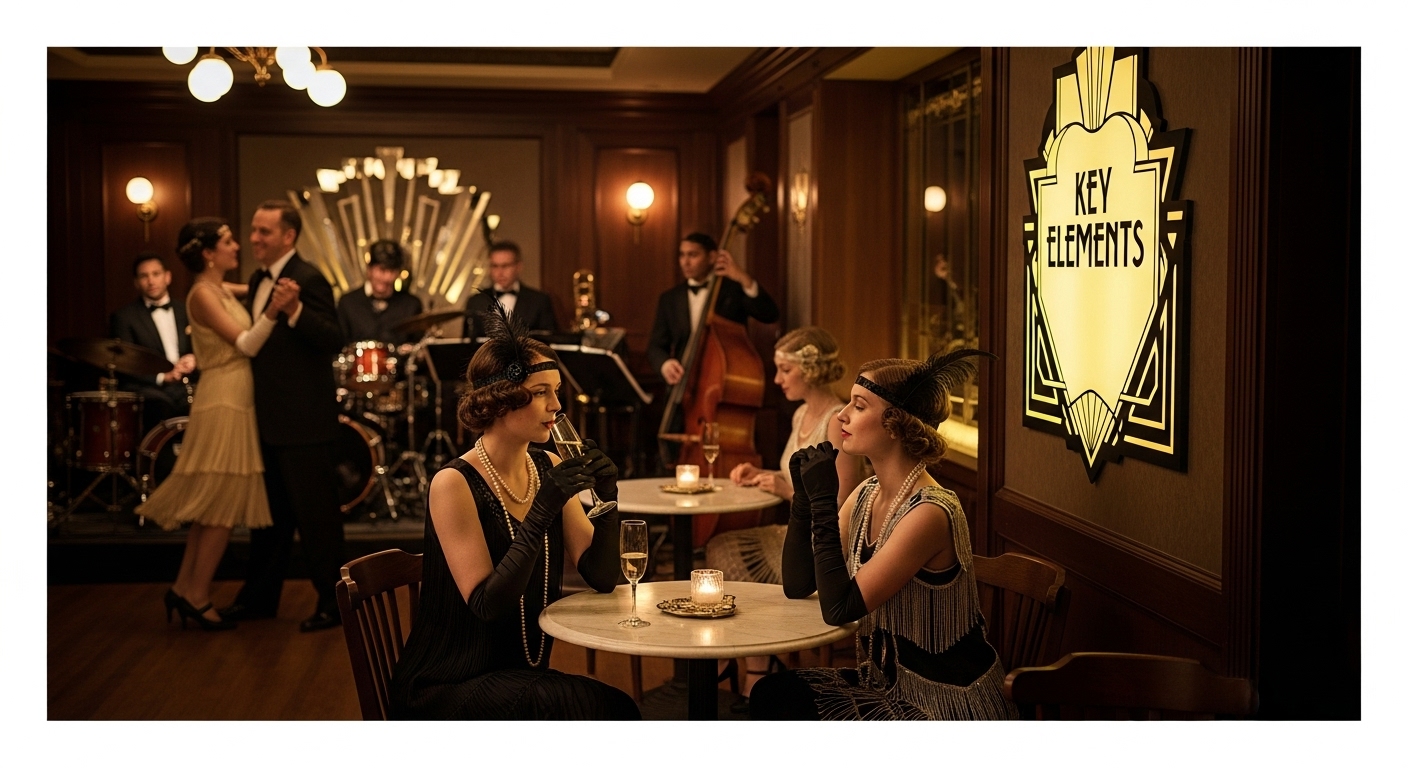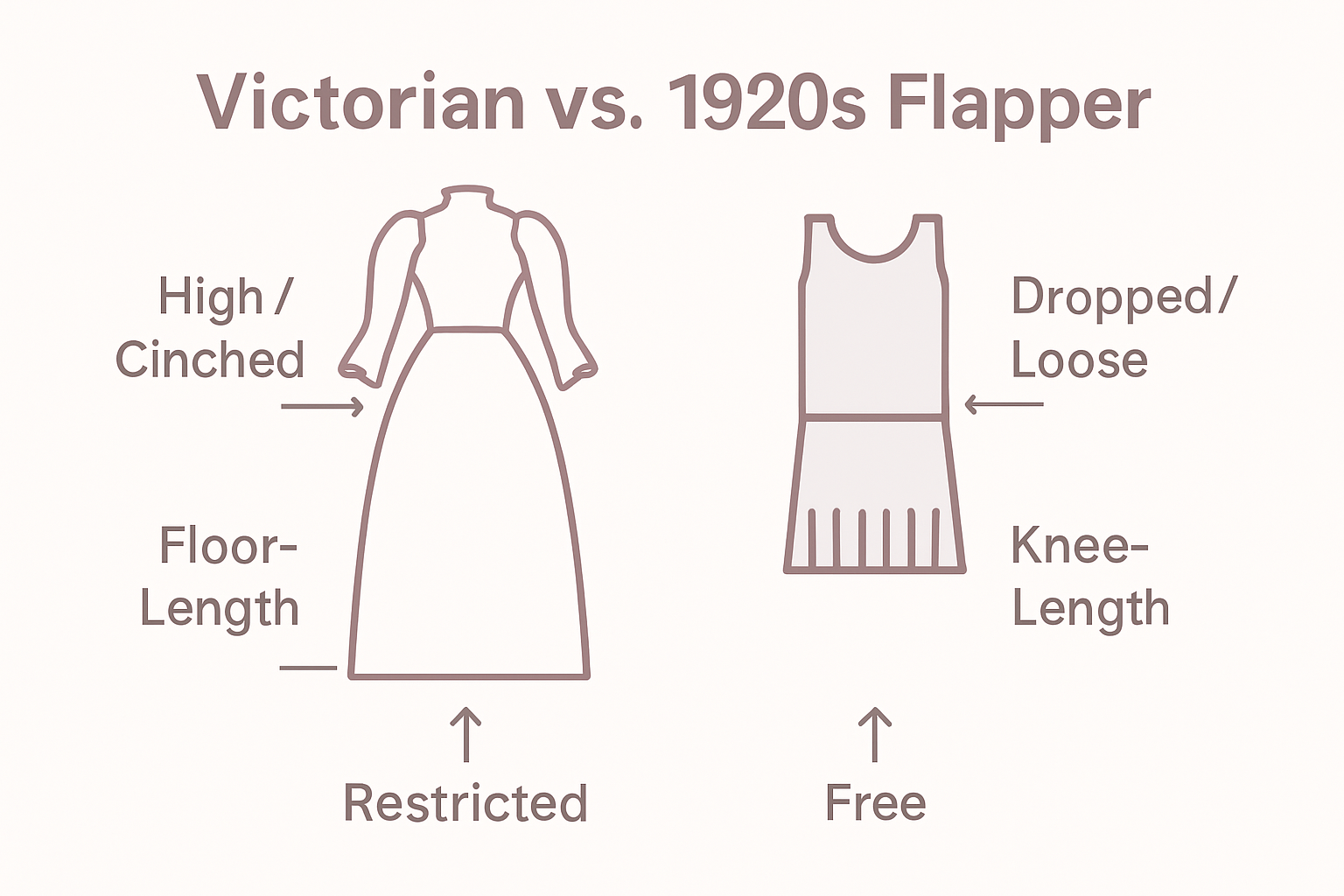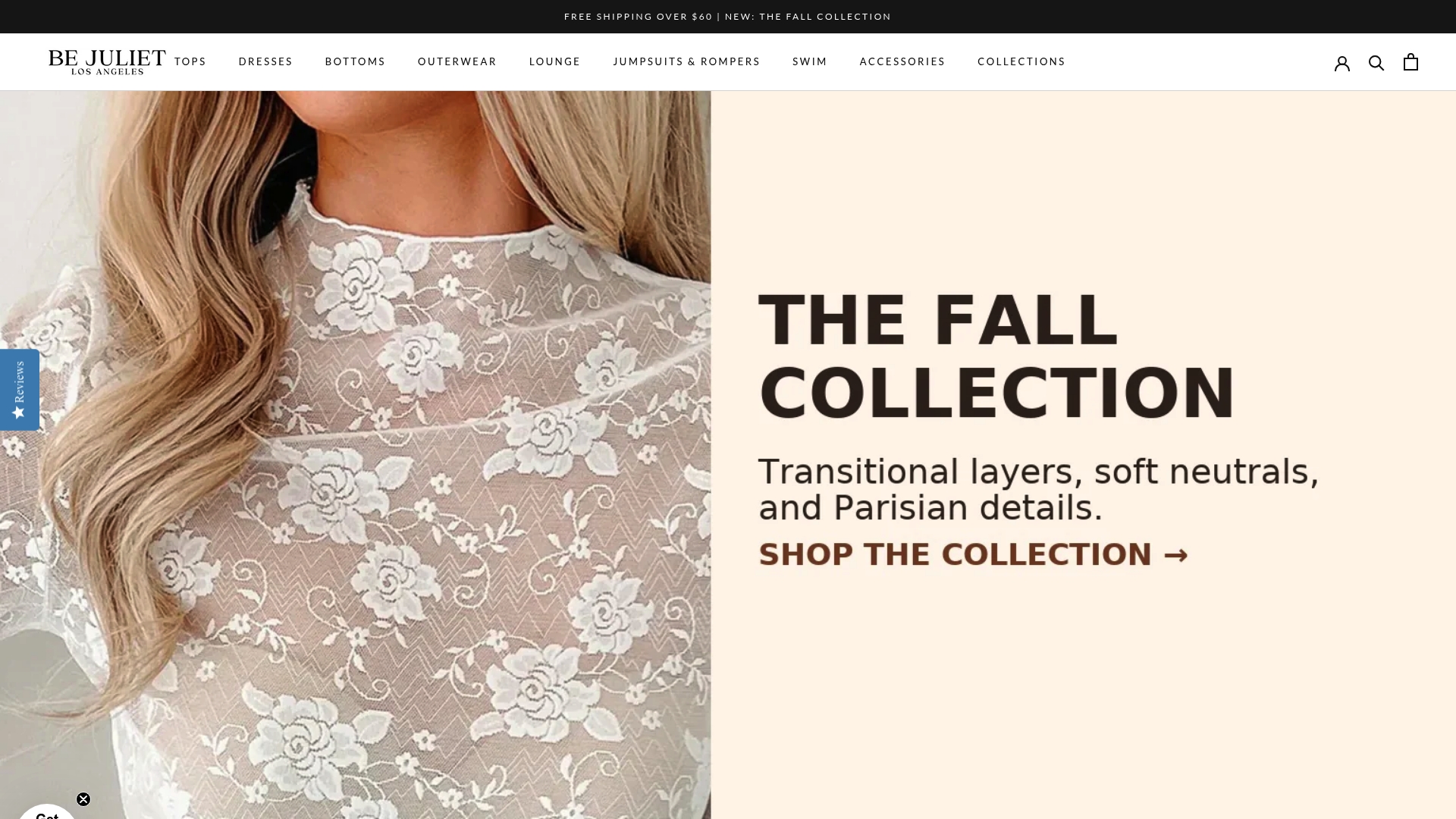Understanding 1920s Style Women: Fashion and Influence
The flapper dress and bold beads became symbols of a new era when women embraced change with every outfit. People think the 1920s were just about glitz and parties. In reality, hemlines jumped higher than ever before and corsets almost disappeared overnight—freeing women in ways America had never seen.
Table of Contents
- The Essence Of 1920s Women’s Fashion
- Cultural Shifts: The Role Of Women In The 1920s
- Key Elements Of 1920s Style And Their Symbolism
- Influence Of 1920s Style On Modern Fashion Trends
Quick Summary
| Takeaway | Explanation |
|---|---|
| 1920s fashion symbolized women’s empowerment. | Fashion in the 1920s challenged traditional norms, representing women’s new social and political autonomy. |
| Flapper style revolutionized women’s clothing. | The flapper style featured loose silhouettes and shorter hemlines, allowing for greater physical freedom and expression. |
| Fashion reflected cultural and social changes. | The designs of the 1920s were influenced by jazz, the Harlem Renaissance, and the women’s suffrage movement, merging style with cultural identity. |
| Accessorizing was a form of self-expression. | Items like cloche hats and pearl necklaces were not just decorative but symbolic of modernity and personal style. |
| 1920s influences persist in modern fashion. | Contemporary designers draw inspiration from dropped waists and art deco patterns, showcasing the era’s lasting impact on today’s styles. |
The Essence of 1920s Women’s Fashion
The 1920s represented a revolutionary period of fashion liberation for women, symbolizing profound social transformation through clothing. This era, often called the Roaring Twenties, witnessed women challenging traditional dress codes and expressing unprecedented personal freedom through their sartorial choices.
Breaking Social Boundaries Through Fashion
Women’s fashion in the 1920s was more than aesthetic—it was a powerful statement of social rebellion. The iconic flapper style emerged as a direct rejection of restrictive Victorian-era clothing, featuring loose silhouettes that allowed unprecedented physical movement. According to research from the New York Public Library, these garments represented women’s emerging political and social autonomy.
Key characteristics of 1920s women’s fashion included:
- Dropped waistlines that eliminated traditional corset structures
- Shorter hemlines rising scandalously above the ankle
- Lightweight, straight-cut dresses enabling greater physical freedom
Aesthetic and Cultural Significance
The fashion of this era reflected deeper cultural shifts. Jazz music, the Harlem Renaissance, and women’s suffrage movements all influenced clothing design. Art deco geometric patterns, bold color combinations, and intricate beadwork became hallmarks of a new aesthetic that celebrated individuality and sophistication.
If you’re curious about exploring modern fashion inspirations from this remarkable era, read our guide on finding timeless fashion inspiration. The 1920s remain a pivotal moment in fashion history—a time when clothing became a powerful medium of personal expression and social change.
The following table summarizes the defining features and symbolic meanings of key elements of 1920s women's fashion for easy reference.
| Fashion Element | Description | Symbolic Significance |
|---|---|---|
| Dropped Waistlines | Waistline falls lower on the torso, often at hips | Rejection of traditional constraints |
| Short Hemlines | Dresses rise above the ankle | Increased personal freedom |
| Straight-Cut Dresses | Loose, lightweight and non-restrictive | Liberation from Victorian fashion |
| Cloche Hats | Close-fitting bell-shaped hats | Embracing modern, streamlined style |
| Pearl Necklaces | Long, draped strands of pearls | Break from conservative jewelry norms |
| Beaded Accessories | Evening bags, headpieces with intricate beadwork | Sophistication and self-expression |
Cultural Shifts: The Role of Women in the 1920s
The 1920s marked a transformative era for American women, characterized by significant social and cultural upheavals that redefined their role in society. This period represented a dramatic departure from traditional expectations, with women challenging long-standing societal norms and claiming unprecedented personal and professional freedoms.
Political and Social Empowerment
The decade began with a monumental achievement—women’s suffrage. Research from Oklahoma State University highlights how the right to vote catalyzed broader social transformations. Women were no longer content with being confined to domestic spaces, instead pursuing education, professional careers, and public leadership roles.
Key areas of women’s expanding social influence included:
- Political representation through voting and civic engagement
- Economic independence by entering professional workforce
- Educational opportunities in universities and professional training
Cultural Revolution and Personal Expression
The cultural landscape of the 1920s witnessed radical reimagining of women’s identity. The emergence of the “New Woman” challenged restrictive Victorian ideals, celebrating personal autonomy and individual expression. Women began participating more visibly in arts, literature, and entertainment, breaking traditional gender constraints.
The Harlem Renaissance particularly exemplified this cultural transformation, with Black women artists, writers, and performers creating powerful narratives of identity and resistance. Jazz music, performance arts, and literature became platforms for expressing complex social experiences and challenging racial and gender stereotypes.
If you’re intrigued by how fashion intersects with social movements, explore our guide on feminine style evolution. The 1920s represent more than a fashion moment—they symbolize a profound revolution in women’s social consciousness and collective empowerment.
Key Elements of 1920s Style and Their Symbolism
The 1920s fashion landscape was a complex tapestry of rebellion, liberation, and artistic expression. Far beyond mere clothing, each garment and accessory represented a profound statement about women’s changing social roles and personal identities.

Clothing as Political Statement
Flapper dresses emerged as revolutionary garments that symbolized women’s newfound freedom. According to Julia Wolffe’s research on 1920s fashion, these designs were intentionally crafted to challenge existing social norms. The straight, loose silhouettes deliberately rejected restrictive Victorian clothing, offering women unprecedented physical and metaphorical mobility.

Key symbolic elements of 1920s women’s fashion included:
- Dropped waistlines representing rejection of traditional feminine constraints
- Short hemlines signaling increased personal autonomy
- Lightweight fabrics enabling greater physical movement and independence
Accessories and Personal Expression
Accessories in the 1920s were not mere decorative elements but powerful tools of self representation. Cloche hats, which hugged the head closely, symbolized a streamlined, modern aesthetic. Long pearl necklaces represented both elegance and a break from conservative jewelry traditions. Beaded evening bags and elaborate headpieces communicated a woman’s sophistication and her willingness to challenge societal expectations.
If you are fascinated by how fashion communicates cultural narratives, explore our guide on understanding statement pieces in fashion. The 1920s stand as a remarkable period where clothing transcended utility, becoming a profound language of personal and collective liberation.
Influence of 1920s Style on Modern Fashion Trends
The 1920s fashion revolution continues to resonate powerfully in contemporary style, proving that true design transcends temporal boundaries. Modern designers consistently draw inspiration from this transformative decade, reinterpreting its bold aesthetic for current fashion landscapes.
Enduring Design Elements
Research from Sonoma State University reveals the lasting impact of 1920s design principles. Contemporary fashion frequently resurrects and reimagines iconic elements from this era, demonstrating the timeless appeal of its revolutionary approach to women’s clothing.
Key 1920s design elements that persist in modern fashion include:
- Straight, loose silhouettes that prioritize comfort and movement
- Embellished accessories like beaded clutches and statement jewelry
- Art deco geometric patterns influencing print and textile design
Contemporary Reinterpretations
Modern designers continuously pay homage to 1920s style through strategic reinterpretations. Runway collections frequently feature dropped waistlines, intricate beadwork, and lightweight fabrics that echo the flapper aesthetic. Evening wear, in particular, demonstrates a profound connection to 1920s glamour, with sequined dresses and elaborate headpieces drawing direct inspiration from the era’s most iconic looks.
If you’re passionate about understanding how historical fashion trends evolve, explore our guide on current fashion trends. The 1920s stand as a testament to fashion’s power to reflect and reshape societal dynamics, proving that true style is timeless.
Experience Timeless Self-Expression Inspired by 1920s Women
Fashion in the 1920s was a rebellion against limits and an embrace of empowerment, offering women new freedom in how they presented themselves. If you have been searching for styles that break old rules and let you express confidence, beauty, and individuality every day, you already understand the desire explored throughout this article. Many modern wardrobes still feel constrained by the same limitations discussed in the article: restricted movement, lack of unique self-expression, and the challenge of finding clothing that truly echoes your inner spirit. Discovering a collection that nods to the daring spirit of flapper dresses, art deco flourishes, and bold independence can make all the difference in how you feel.
Explore our New In arrivals at Be Juliet to find styles that empower you to live that liberated spirit every day. Each piece blends the timeless inspiration of the 1920s with the comfort and modern elegance you crave.

Ready to express your own version of fearless femininity, whether it is effortless blouses or thoughtfully designed crop tops? Visit Be Juliet and start curating a wardrobe that celebrates the very essence of love and transformation, just like the women who redefined fashion a century ago. Shop now and let your wardrobe tell your story of confidence and change.
Frequently Asked Questions
What were the key features of 1920s women’s fashion?
The key features of 1920s women’s fashion included dropped waistlines, shorter hemlines that rose above the ankle, and lightweight, straight-cut dresses. These elements allowed for greater physical freedom and represented a shift away from restrictive Victorian clothing.
How did the fashion of the 1920s reflect women’s social changes?
The fashion of the 1920s was a powerful statement of women’s social changes, symbolizing their emerging political and social autonomy. The flapper style, in particular, challenged traditional dress codes and reflected women’s newfound freedom and independence.
What influenced the aesthetics of 1920s women’s clothing?
The aesthetics of 1920s women’s clothing were influenced by cultural shifts such as jazz music, the Harlem Renaissance, and the women’s suffrage movement. Bold color combinations, art deco geometric patterns, and intricate beadwork became hallmarks of the fashion of this era.
How do modern fashion trends draw inspiration from the 1920s?
Modern fashion trends continue to draw inspiration from the 1920s by incorporating elements such as straight, loose silhouettes, embellished accessories, and art deco patterns. Contemporary designers often reinterpret these features, demonstrating the lasting impact of 1920s style on today’s fashion.
